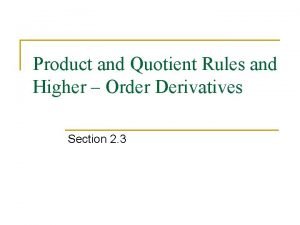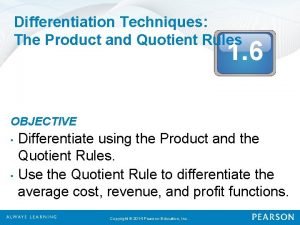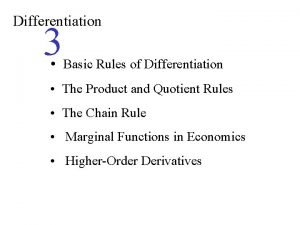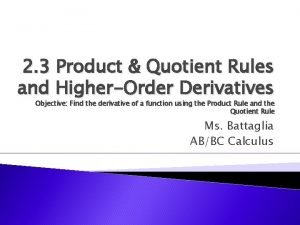Review of Derivatives Power rule product rule quotient







- Slides: 7

Review of Derivatives Power rule, product rule, quotient rule and chain rule

The Power Rule Remember, the power rule only works on functions of the form y = xn. n The power rule says that y’ = nxn-1 n Examples: n ny = x 2, so y’ = 2 x n y =x 1/2, so y’ = ½x-1/2 n y = x -1, so y’ = -x -2

The Product Rule n n n The product rule can be used when two functions are multiplied together. If y = f(x)g(x), then y’ = f’(x)g(x) + f(x)g’(x) Examples: n n n If y = xsinx, then y’ = sinx +xcosx If y = (3 x)(5 x+1), then y’ = (3)(5 x+1) + (3 x)(5) Of course, you must remember to simplify your answers!

The Quotient Rule n n n The quotient rule can be used when two functions are being divided. If y = f(x)/g(x), then y’ = [g(x)f’(x) – f(x)g’(x)]/(g(x))2, or (lodhi – hidlo) / lolo ! Example: If y = sinx/cosx, then y’ = [cosx(cosx) – sinx(sinx)]/cos 2 x n What does this simplify to? ? ? n

Trigonometric Derivatives If y = sinx, then y’ = cosx n If y = cosx, then y’ = -sinx n If y = tanx, then y’ = sec 2 x n If y = secx, then y’ = secxtanx n If y = cscx, then y’ = -cscxcotx n If y = cotx, then y’= -csc 2 x n

The Chain Rule The chain rule is used on composition functions. n You must identify the inside function and the outside function. n The chain rule says if y = f(g(x), then y’ = f’(g(x))*g’(x), or the derivative of the inside times the derivative of the outside n

The Chain Rule (cont’d) n Examples: n If y = sin(x 2), then y’ = 2 xcos(x 2) n If y = (2 x+1)3 then y’ = 2*3(2 x+1)2 n Remember, the product rule and the quotient rule may also need to be used along with the chain rule!! n If y = (2 x+1)3(3 x+2)2, then y’ = 2*3(2 x+1)2(3 x+2)2 + (2 x+1)3(3)(2(3 x+2)) n Don’t forget to simplify!!!












